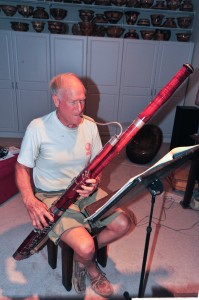Blake Patterson
Growing up in Royal Oak, Michigan, Blake Patterson played with electricity, chemicals, motors, model airplanes, and the local fauna. In 10th grade he took bassoon lessons, and two years later tooted with six orchestras and three bands. After engineering and math degrees at the University of Michigan he answered JFK’s call, joined the Peace Corps, and taught two years at the University of Ife in Nigeria. He earned a Ph.D. in physics at UC Berkeley, but his first job was second bassoonist in the New Jersey Symphony, where he met his lovely wife, Ellen Jackson. He played with many fine New Jersey orchestras, including twenty years with the Garden State Philharmonic and the Metro Lyric Opera.
After he joined Bell Labs, Blake and Ellen bought a 30-room fixer-upper in Rumson, NJ, where they hosted dozens of chamber-music concerts. When they re-decorated the master bath, Ellen asked his favorite color: “Wood!” They covered the walls with thin pine strips. They refinished just about every other square inch inside and outside that home. Blake gained lots of on-the-job problem-solving experience maintaining two acres and old structural, electrical, plumbing, and heating systems. He built a dock, grape arbor, pergola, railings, furniture, etc. They raised two fine people: Grant, who was Rumson’s 2002 valedictorian and now writes software in San Francisco, and Greer, who is a fine soprano and teaches bilingual students in a Brooklyn elementary school.
In 2007 the Jackson-Pattersons moved to a new, low-maintenance condo in the Greenbriar Falls senior complex in Tinton Falls, NJ. At a friend’s suggestion, Blake bought an inexpensive lathe that he used to make a few dowels. He later struggled to turn a large log into a small bowl and lots of sawdust. The inefficiency and danger of that effort prompted him to glue together a few pieces of wood into a crude bowl shape that was easier to carve while making less sawdust. He had re-invented the technique of “segmented” wood-turning. Roughly one in a hundred turners are “segmenters;” the other 99 start with one piece of wood. Experienced segmenter George Nazareth of New England writes on-line that a segmenter must be precise, meticulous, patient, and “a little nuts.”
Largely self-taught, Blake draws on his home-maintenance skill to improve the bowl-making process, along with ideas and advice from experienced turners and books. Some of the fun of turning bowls is creating “jigs” that make the process safer, faster, and more accurate.
It takes Blake 10 to 30 hours to complete one bowl.
